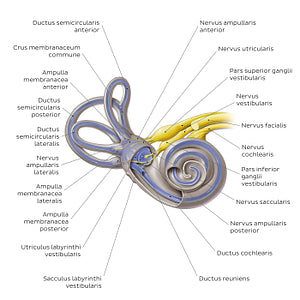Paul Kim
Membranous labyrinth (Latin)
Membranous labyrinth (Latin)
The labyrinthus membranaceus is suspended within the perilymph of the labyrinthus osseus thus mirroring its overall structure. The central part of the labyrinthus membranaceus is located within the bony vestibulum. It consists of two sacs: utriculus and sacculus, which communicate via a small duct called the ductus reuniens. The utriculus lies in the posterior part of the vestibulum, while the sacculus lies anteriorly. The three membranous ductus semicirculares branch from the utriculus and pass through the canales semicirculares. Similar to their bony counterparts, the ducts originate with ampullae membranaceae (anterior, posterior, lateral). The ductus anterior and posterior unite as well, forming the crus membranaceum commune.The bony cochlea houses the membranous ductus cochlearis which follows its spiral course. The whole labyrinthus membranaceus is filled with endolymph. Movement of endolymph stimulates the receptor cells within the walls of the labyrinthus, producing neuronal stimuli related to balance and hearing. These stimuli are conveyed via the nervus vestibulocochlearis, whose components can be seen innervating different parts of the labyrinthus. Essentially, the nervus vestibularis innervates the utriculus, sacculus and ductus semicirculares, via its branches, conveying the information about balance. Branches of the nervus cochlearis innervate the organum spirale (Cortii) that is located in the cochlea, providing information about hearing.
Normaler Preis
$7.56 USD
Normaler Preis
Verkaufspreis
$7.56 USD
Grundpreis
pro
Verfügbarkeit für Abholungen konnte nicht geladen werden


#D4B112
#5A67A8
#8D741C
#362F34
#F3E891 und #9FA9D1

